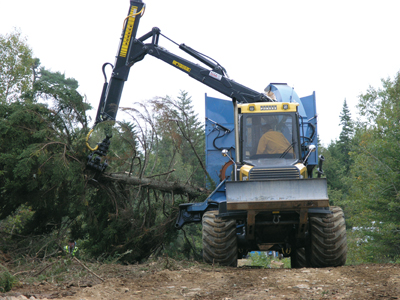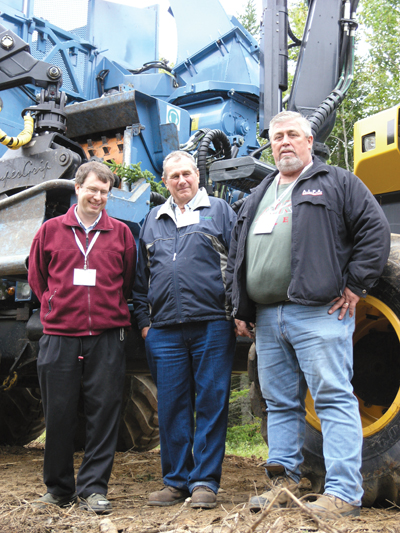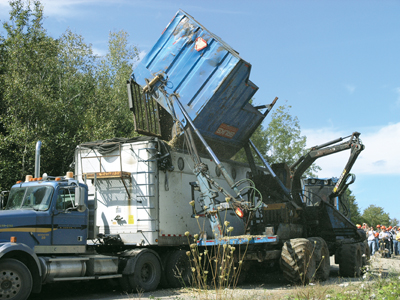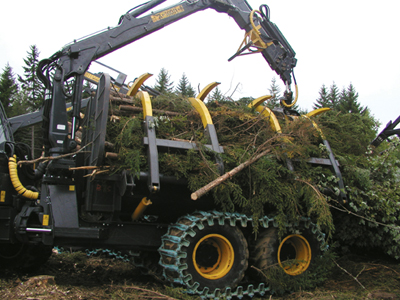
A Chip off Any Block
May 27, 2009
By
Scott Jamieson
“Our operations are a little bit different,” admits Robin Barrett of Barrett Enterprises with a smile, as if the 22-year-old forwarder-mounted Bruks chipper working over his shoulder weren’t a clue enough.
“Our operations are a little bit different,” admits Robin Barrett of Barrett Enterprises with a smile, as if the 22-year-old forwarder-mounted Bruks chipper working over his shoulder weren’t a clue enough. The second generation, family-run harvesting, firewood, biomass, and hauling business located just outside downtown Halifax certainly faces unique challenges.
“When we’re anywhere near houses, which is much of the time, we have to work around noise by-laws. We can’t start before 7:00 am and have to quit by 9:30 pm.”
 |
|
|
|
So much for maximizing machine utilization. But proximity to Halifax does have advantages. A hungry urban firewood market right on the doorstep doesn’t hurt a business whose firewood processing yard will churn out 1,000 full cords and about the same amount of 8-ft firewood this year. A broad mix of local bioenergy clients that range from greenhouses to power generators and can handle the full range of wet to dry biomass is also a help. And when you’re in the biomass salvage business, being at the heart of an expanding suburban market can’t hurt either. In fact, it makes a nice little business if you’re set up to handle it.
“Part of our expertise is to go to a site where they’re building a grocery store or other large building, and remove all the merchantable timber and then chip the rest. You have to be flexible and mobile, but that’s our business.”
Over the years Barrett Enterprises has built a team that includes a Ponsse Beaver-Caribou harvesting team, three chip trailers with Keith walking floors (two BWS 46-ft bought in 2000 and 2001, and one Manac 48 ft added in 2007), a Western Star tractor, three Rottne Rapid forwarders (1990, 1997, 2001), plus two service trucks.
Swift of foot
But being flexible is really where the battle-scarred Bruks chipper comes in. Mounted on an 8WD Rottne forwarder, the old warhorse can be brought in quickly to small lots, drives out to the slash itself, chips it, and then dumps it into one of Barrett’s three lie floor trailers.There may be better options for non-stop, high-volume roadside chipping, Barrett says, but then a massive grinder would look a little lost in a sub-development.
“Can you see a big grinder coming in here?” he asks, sweeping his arm across a small lot just beside the family sawmill that was the site of a demo for the Canadian Woodlands Forum/CanBio field tour last September. “Where would it set up, and how long could you keep it fed? We’re a bit of a niche market, and it’s feast or famine. One day we’re doing a large roadside chipping job, the next small jobs clearing everything, and we survive by being able to do it all, close to a city. We can send a guy in with a powersaw on small sites, then the chipper drives around cleaning up. It can also drive on the road from lot to lot.”
 |
|
| Second- generation sawmiller David Barrett (centre) with son Robin (left) and long-time chipper operator Mike Barkhouse and the new Ponsse/Bruks 450-hp chipper. The family company got into chipping to find an outlet for its pulp material because it was too far from area pulp mills to be a preferred supplier.
|
On larger jobs, Barrett might have a sub-contractor come in to log the site and process and sort out sawlogs, leaving the rest at roadside for the chipper. It’s on the larger-scale roadside jobs that the older Bruks chipper found its limitations. Bought in 1986 and still boasting the original operator Mike Barkhouse, it has brought home the bacon for 22 years, and still works on an as-needed basis. But at 250 hp, it lacks the muscle to compete on some of the larger jobs Barrett likes to bid on. To keep up, the company recently added a brand new 450-hp Bruks chipper mounted on a Ponsse Buffalo-King 18-tonne forwarder. The package came from dealer ALPA Equipment, and having one party take ownership of the unit was a deal breaker for Barrett. “It comes from two suppliers, but we wanted to have one company take responsibility for the whole thing working out. ALPA did, and so far there have been no serious issues.”
It joined the team this past August and has proven to be a real producer, Barrett says. While the original chipper brought out two 30-ton van loads per day (nine hours), the 450-hp unit was already topping three loads when Canadian Biomass was on site in mid-September. That 50%+ boost is all the difference.
“We need a wide range of work to survive, and the older chipper was having a hard time competing in the larger jobs. Now we can bid on those again, since the new one will keep up at roadside.”
At close to $900,000 with all options and materials, it had better. Still, it also brings improved fuel efficiency to the table, no small matter for today’s biomass producers. Barrett has long tracked fuel consumption as a core cost. In 2007, the old chipper averaged around 19 litres per bin for the forwarder and chipper combined, depending on the haul. That average means about 4 litres per green ton dumped in the live-floor trailers, or too much given current fuel costs Barrett explains.
 |
|
| The original warhorse 250-hp Bruks chipper dumps a load into one of three vans with Keith walking floors. The new Ponsse/Bruks chipper carries 21 m3 loose packed per trip versus 16 m3 in the older chipper. That 30% boost, along with the muscle that 450-hp provides, means some 50% more production.
|
“Best bets are that fuel per ton for hogs (grinders) is around 3 litres, while larger chippers are at 2 or a little more, so I figured we couldn’t compete head on with the older machine for long. It’ll be another couple of months before I know the total for the new machine, but let’s face it – a lot has changed in 22 years. I expect to be around 2.5 litres/ton for the total package, from the woods into the van.”
He puts this down to a combination of a much more efficient forwarder (literally the Mercedes of forwarders, as Ponsse is powered by Mercedes engines), a new generation of hydraulics and controls, and the new Scania chipper engine. Efficient operators help too, and here he adds that the new unit includes many of the improvements and modifications his operator had put on his wish list during 22 years of running the older chipper.
“We went to Sweden to see the chipper before buying, and Mike had a list of over 20 improvements he wanted with the new chipper. They were all included on the new model. You add that to the new forwarder and big cab, and you have a happy operator.”
That, Barrett says, is probably more important than any gear when it comes to a successful bush chipping operation.
“An experienced, motivated staff is key – From the guy in the woods preparing the wood, to the forwarder operators bringing it to roadside, to the operator feeding the chipper. This chipper will make an excellent energy product, but the material has to be kept clean; that’s critical. It’s not garbage. Otherwise you’ll lose your shirt.”
While some chipper or grinder operations will scrape clean a chip “pad” at roadside, Barrett’s crew simply watches where they pile the wood, and tries to concentrate the fibre in higher piles to limit the material in contact with the ground. That, and a little care in loading the material makes all the difference. Also, when a forwarder is used to bring material to roadside, Barrett relies on a modified machine with a long, aluminum sub-frame that prevents the material from dragging along the ground.
“If there is one thing I can’t stress enough, it’s the need to keep the material clean through the entire process, right up to the chipper.” With that, he turns to watch his Ponsse/Bruks chipper work at DEMO. “I guess this means we’re at it for another 22 years at least,” he concludes.
It’s all about payload
Visitors to the Ponsse/ALPA booth at DEMO 2008 in Halifax this past September not only saw Barrett Enterprises’ newest Ponsse/Bruks bush chipper in action, they were also treated to a first look at one of the Finnish-based supplier’s biomass solutions. The Bio Transportation System (BTS) is essentially a way to allow a conventional forwarder to maximize its payload of cumbersome slash to roadside. It’s all about moving less air and more wood, and Ponsse’s BTS does this by using sloped stakes to compress the slash as it moves through the block. It applies 10 tons of hydraulic compression through a 58-degree inward travel arc to more than double the weight of biomass removed per turn. Ponsse says field tests have shown payloads in the 10 to 12 ton range, as well as allowing the forwarder operator to keep a narrow profile through the stand to avoid damaging residuals or advanced growth. Efficiency can be improved by adding a brush grapple and fixed heel to the crane. When not moving slash, the forwarder can be used to move cut-to-length wood to roadside.
 |
|
|
|
The system was developed by the company’s North American office as a way for contractors to use existing assets to get into the biomass game. It’s a common sense approach that many loggers, and competitors, at DEMO 2008 appreciated. Yet as long-time biomass contractor Robin Barrett says, cleanliness is next to godliness when it comes to biomass. He uses a makeshift extended bunk on his own modified forwarder to bring clean slash to his drum chipper, and while impressed with the BTS’ ability to haul a lot of slash at DEMO, he commented that he’d like to see a similar device added to future models. Ask and you shall receive: Ponsse’s technical support specialist Stacy Wagler told Canadian Biomass that the company has exactly that bunk extender available as an option for contractors that need extra-clean slash. It adds about a metre of support to the back end and is all part of Ponsse’s proactive approach to biomass harvesting, the forest machinery veteran adds.
“We’ve decided we’re going to be a player in the biomass sector. Our factory in Finland is working on solutions and has a biomass R&D program. But we’re also looking at bringing practical solutions now to our North American contractors, and the BTS is part of that. There will be more.” We look forward to it.
Print this page